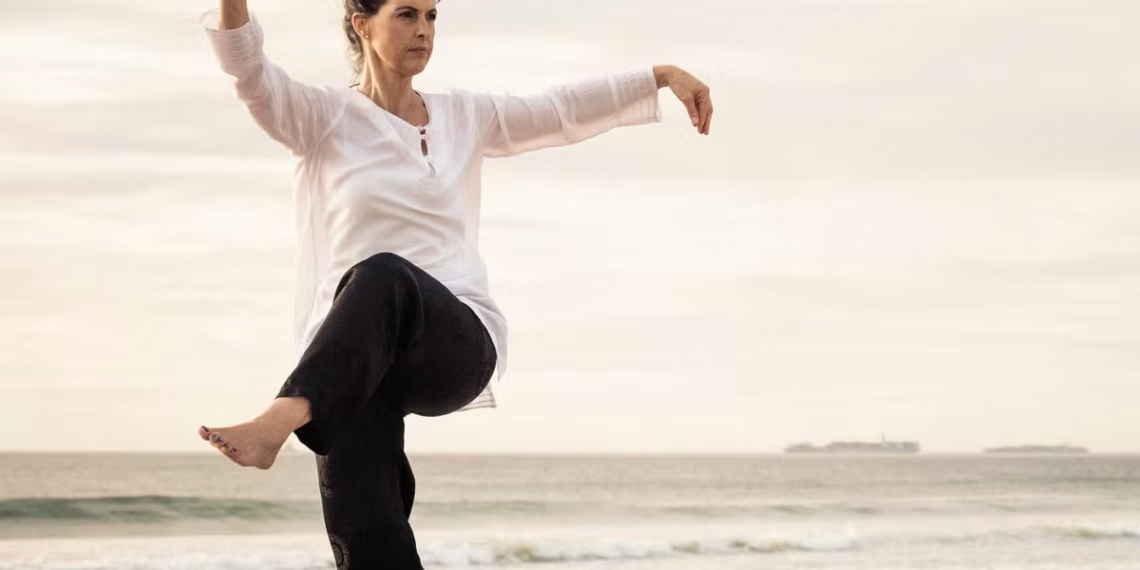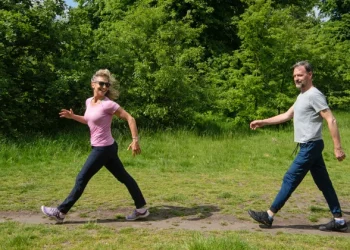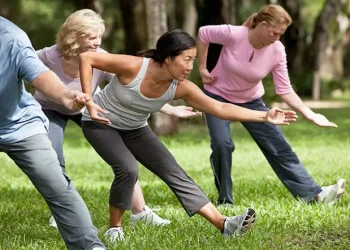The ancient Chinese practice of Tai Chi has captivated practitioners worldwide for centuries, offering a unique blend of meditation, martial arts, and health cultivation. At the heart of this profound discipline lies a deceptively simple yet transformative practice: Tai Chi walking breathing. This fundamental exercise serves as both a gateway for beginners and a lifelong refinement for masters, embodying the essential principles that make Tai Chi such a powerful tool for physical health, mental clarity, and spiritual development.
The Foundation of Breath in Tai Chi
Before exploring Tai Chi walking breathing specifically, it’s essential to understand the role of breath within the broader Tai Chi framework. In Chinese philosophy, breath is intimately connected to “qi” (pronounced “chee”), the vital life energy that flows through all living things. The Chinese character for qi itself depicts steam rising from rice, suggesting both the material and ethereal nature of this life force. Through conscious breathing, Tai Chi practitioners learn to cultivate, circulate, and direct qi throughout the body, promoting health, vitality, and internal strength.
Unlike the forceful, chest-based breathing common in Western exercise, Tai Chi emphasizes natural, diaphragmatic breathing that engages the lower abdomen. This breathing style, sometimes called “belly breathing” or “abdominal breathing,” mirrors the effortless way infants breathe and represents a return to our most natural respiratory pattern. When we breathe this way, the diaphragm descends on inhalation, allowing the lungs to fill completely while the belly gently expands. On exhalation, the diaphragm rises as the belly naturally draws inward, creating a smooth, continuous cycle.
Understanding Tai Chi Walking
Tai Chi walking, known in Chinese as “xing bu” or walking meditation, forms one of the most accessible yet profound practices within the Tai Chi system. While Tai Chi forms involve complex sequences of movements with specific names and applications, Tai Chi walking distills the art down to its essence: mindful, coordinated movement powered by breath and intention.
The walking itself appears simple to an outside observer—slow, deliberate steps that seem to flow like water. However, this simplicity belies a sophisticated internal process. Each step involves a complete weight shift, careful attention to posture and alignment, and precise coordination with the breath. The feet remain connected to the earth while the body moves through space with minimal wasted motion, embodying the Tai Chi principle of efficiency and naturalness.
The Breathing Pattern: Natural Rhythm and Flow
The breathing technique for Tai Chi walking follows a natural, unrestricted pattern that synchronizes with the body’s movement. The fundamental pattern is straightforward: inhale as you prepare and shift your weight, exhale as you complete the step and settle into the new position. However, this simplicity requires practice to master, as it demands that we override our habitual breathing patterns and develop new awareness.
When beginning Tai Chi walking breathing practice, start with natural breathing—don’t force anything. Simply observe your breath as you walk slowly. Notice where the breath goes in your body, whether it’s shallow or deep, fast or slow. This observation without judgment forms the foundation of mindful breathing. As you become more comfortable, begin to gently guide the breath downward, allowing it to settle into the lower abdomen rather than staying trapped in the upper chest.
The inhalation typically occurs during the “yin” phase of movement—when you’re gathering energy, preparing, or drawing back. As you breathe in through your nose, imagine drawing clean, vital energy into your body. Feel your lower abdomen expand gently, almost as if you’re breathing into your center of gravity, located about two inches below your navel in the lower dantian. This area serves as the body’s energetic reservoir in Chinese medicine.
The exhalation happens during the “yang” phase—when you’re releasing energy, extending, or moving forward. As you breathe out through your nose (or sometimes softly through the mouth), allow the breath to release naturally without force. The lower abdomen draws gently inward, but this happens as a consequence of the exhalation, not through muscular effort. This natural contraction helps stabilize the core and root your connection to the ground.
Coordinating Breath and Movement: A Step-by-Step Approach
The magic of Tai Chi walking breathing emerges when breath and movement become one seamless flow. This coordination doesn’t happen immediately—it requires patient practice and attention. Here’s how the coordination typically unfolds:
Begin standing in a natural position with feet shoulder-width apart, knees slightly bent, and spine gently elongated. Allow your breath to settle into a natural rhythm. As you inhale, begin to shift your weight onto one leg, perhaps 70 percent of your weight. Feel yourself sinking slightly, rooting into the earth. This inhalation phase represents gathering and storing energy.
As you transition from inhalation to exhalation—that brief pause between breaths—you’re at a moment of stillness and potential. This is when internal awareness is heightened. Then, as you begin to exhale, allow the unweighted foot to rise gently and move forward, stepping lightly like a cat. The heel touches first, then the foot rolls forward until it’s completely planted. Throughout this exhalation, you’re releasing energy into the movement, creating a flow from breath to action.
Once the foot is planted, the weight begins to shift forward, and a new inhalation cycle begins. The process repeats with the opposite leg. What makes this coordination challenging is maintaining awareness of breath, posture, weight distribution, and movement quality simultaneously. The mind must remain present and focused, yet relaxed and natural.
As you advance in practice, the breathing may become longer and more refined. Some practitioners can complete an entire step sequence on a single breath cycle, while others may use several breath cycles for one step when moving extremely slowly. There’s no single “correct” speed—what matters is that breath and movement remain harmonized and natural.
How Proper Breathing Enhances Practice
The benefits of proper breathing in Tai Chi walking extend far beyond simple oxygenation. When breath and movement align, practitioners experience multiple layers of enhancement.
Physical Benefits and Body Mechanics
Proper abdominal breathing activates the body’s relaxation response, triggering the parasympathetic nervous system. This creates a cascade of physiological benefits including lowered blood pressure, reduced muscle tension, and improved circulation. The diaphragm’s full range of motion massages internal organs, promoting digestive health and lymphatic drainage.
From a biomechanical perspective, coordinated breathing helps stabilize the core. When you exhale during stepping and weight shifting, the natural engagement of the deep abdominal muscles provides structural support, protecting the lower back and enhancing balance. This internal support allows the larger muscle groups to relax, creating the characteristic softness of Tai Chi movement while maintaining structural integrity.
Mental Clarity and Focus
The breath serves as an anchor for attention, preventing the mind from wandering into past regrets or future anxieties. This focused awareness cultivates a meditative state often described as “moving meditation.” Practitioners report enhanced mental clarity, reduced stress, and improved emotional regulation. The practice becomes a form of mindfulness training, with breath as the central object of awareness.
Energetic Cultivation
From the perspective of Traditional Chinese Medicine, coordinated breathing facilitates the smooth flow of qi through the body’s meridian system. Blockages that cause discomfort or disease can be gradually dissolved through consistent practice. Practitioners often report sensations of warmth, tingling, or flowing energy—signs that qi circulation is improving.
Enhanced Mind-Body Connection
Perhaps most significantly, breath coordination deepens the mind-body connection. You’re not just moving your body or thinking about movement—you’re using breath as a bridge that unifies intention, awareness, and physical action. This integration represents the true essence of Tai Chi as an internal martial art.
Practical Tips for Developing Your Practice
Developing proficiency in Tai Chi walking breathing requires patience and consistent practice. Start with just five to ten minutes daily, focusing on quality over quantity. Practice in a quiet space where you won’t be disturbed, preferably outdoors where you can connect with nature.
Begin by walking at whatever pace allows you to maintain breath awareness. For most beginners, this means walking more slowly than normal but not so slowly that it becomes unnatural or strained. As coordination improves, you can experiment with different speeds, discovering how your breath naturally adjusts.
Pay attention to common mistakes. Many beginners hold their breath during challenging parts of the movement or breathe only into the upper chest. Others try to control the breath too forcefully, creating tension rather than relaxation. Remember that the goal is natural, effortless breathing that flows with movement. If you find yourself struggling, simply return to natural breathing and rebuild the coordination gradually.
Consider working with a qualified Tai Chi instructor who can provide personalized guidance and corrections. While books and videos offer valuable information, an experienced teacher can observe subtle patterns and offer adjustments that accelerate your progress.
The ancient Chinese proverb states that “the journey of a thousand miles begins with a single step.” In Tai Chi walking breathing, each step becomes a complete practice unto itself—a miniature journey that contains infinite depth. As you continue practicing, you’ll discover that what seemed simple at first reveals layer after layer of subtlety and refinement.
The coordination of breath and movement in Tai Chi walking serves as a microcosm of the larger Tai Chi practice and, indeed, of life itself. It teaches us to move through challenges with grace, to remain centered amid change, and to find harmony between effort and ease. Whether you practice for health, meditation, martial skill, or simple enjoyment, Tai Chi walking breathing offers a profound path of self-cultivation that honors both body and spirit.
Begin today with a few mindful steps, breathing naturally and moving slowly. Let each step be complete, each breath be full, and each moment be present. In this simple practice lies the wisdom of centuries and the potential for deep transformation.
- what is tai chi walking breathing practice
- breathing techniques for beginners
- breathing coordination techniques
- breathing for chi cultivation
- qigong breathing practices
- breathing in meditation
- breathing meditation techniques
- breathing for stress relief
- mindful breathing practice
- breathing principles






